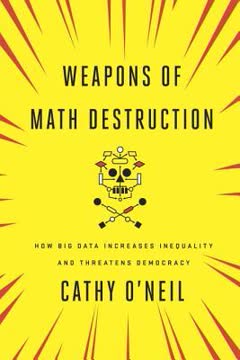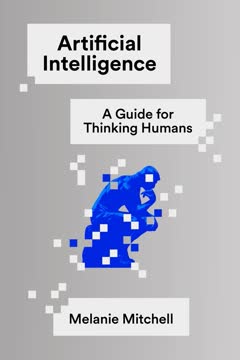Key Takeaways
1. AI's foundations lie in mimicking human intelligence through machines
"AI would be the ultimate version of Google. The ultimate search engine that would understand everything on the web. It would understand exactly what you wanted, and it would give you the right thing."
Historical context. AI's roots trace back to the 1950s, with pioneers like Alan Turing, John McCarthy, and Marvin Minsky laying the groundwork. The field has experienced cycles of excitement and "AI winters," but recent advancements in computing power and data availability have propelled AI into the mainstream.
Key concepts. AI encompasses various subfields:
- Machine learning
- Deep learning
- Natural Language Processing
- Computer vision
- Robotics
The ultimate goal is to create machines that can perform tasks requiring human-like intelligence, such as reasoning, problem-solving, and learning.
2. Data quality and preparation are crucial for successful AI implementation
"Data is the lifeblood of AI. It's how algorithms can find patterns and correlations to provide insights."
Garbage in, garbage out. The success of AI models heavily depends on the quality and quantity of data used to train them. Poor data can lead to biased or inaccurate results, undermining the entire AI initiative.
Key steps in data preparation:
- Data collection from various sources
- Data cleaning and normalization
- Feature selection and engineering
- Data labeling (for supervised learning)
- Data augmentation (when necessary)
Organizations must invest significant time and resources in data preparation to ensure their AI projects have a solid foundation.
3. Machine learning enables computers to learn without explicit programming
"Machine learning is about optimizing processes and involves large amounts of data."
Types of machine learning. There are three main categories:
- Supervised learning: Uses labeled data to train models
- Unsupervised learning: Finds patterns in unlabeled data
- Reinforcement learning: Learns through trial and error
Common algorithms. Machine learning encompasses various techniques:
- Linear regression
- Logistic regression
- Decision trees
- Random forests
- Support Vector Machines (SVM)
- K-Nearest Neighbors (KNN)
These algorithms can be applied to diverse problems, from predicting customer churn to detecting fraudulent transactions.
4. Deep learning revolutionizes AI with neural networks inspired by the human brain
"Deep learning AI is the new electricity."
Neural networks. Deep learning uses artificial neural networks with multiple layers to process complex data. This approach has led to breakthroughs in:
- Image and speech recognition
- Natural language processing
- Autonomous vehicles
- Game-playing AI (e.g., AlphaGo)
Key architectures. Deep learning encompasses various neural network structures:
- Convolutional Neural Networks (CNNs) for image processing
- Recurrent Neural Networks (RNNs) for sequential data
- Generative Adversarial Networks (GANs) for creating new data
While powerful, deep learning requires significant computational resources and large datasets to achieve optimal results.
5. Robotic Process Automation (RPA) offers an accessible entry point to AI adoption
"RPA allows you to use low-code visual drag-and-drop systems to automate the workflow of a process."
Business benefits. RPA can:
- Reduce costs by automating repetitive tasks
- Improve accuracy and consistency
- Free up human workers for higher-value activities
- Enhance customer satisfaction through faster processing
Implementation considerations. When adopting RPA:
- Start with simple, rule-based processes
- Ensure buy-in from both IT and business units
- Develop a clear governance structure
- Plan for scalability and maintenance
RPA serves as a stepping stone to more advanced AI applications, allowing organizations to gain experience with automation before tackling more complex projects.
6. Natural Language Processing (NLP) powers human-computer communication
"NLP is the use of AI to allow computers to understand people."
Key applications. NLP enables:
- Chatbots and virtual assistants
- Machine translation
- Sentiment analysis
- Text summarization
- Speech recognition
Challenges. NLP must overcome:
- Ambiguity in language
- Context-dependent meaning
- Sarcasm and idioms
- Multiple languages and dialects
Recent advancements in deep learning, particularly transformer models like BERT and GPT, have significantly improved NLP capabilities, enabling more natural and context-aware language understanding and generation.
7. Physical robots represent the ultimate manifestation of AI in the real world
"Robots can range in size, from tiny machines that can explore our body to massive industrial systems to flying machines to underwater vessels."
Types of robots. The field encompasses various categories:
- Industrial robots for manufacturing
- Service robots for tasks like cleaning or customer assistance
- Medical robots for surgery and patient care
- Autonomous vehicles
- Drones and unmanned aerial vehicles (UAVs)
AI integration. Robots increasingly incorporate AI to:
- Perceive and navigate their environment
- Make decisions and adapt to changing conditions
- Interact safely with humans
- Learn and improve their performance over time
As AI advances, robots are becoming more versatile, autonomous, and capable of operating in complex, unstructured environments.
8. Implementing AI requires strategic planning and cross-functional collaboration
"Business leaders need to understand and realize that the adoption of Artificial Intelligence is a journey and not a sprint."
Key steps for AI implementation:
- Identify high-impact use cases
- Assess data readiness and infrastructure
- Build a cross-functional team
- Choose appropriate tools and platforms
- Develop and test AI models
- Deploy and monitor the solution
- Continuously iterate and improve
Common challenges:
- Lack of AI expertise
- Data quality and availability issues
- Integration with legacy systems
- Ethical concerns and bias
- Resistance to change
Successful AI adoption requires a holistic approach that considers technology, people, and processes.
9. The future of AI promises both immense potential and significant challenges
"AI executed irresponsibly has the power to destabilize large parts of the world economy by causing, as many people fear, a shrinking workforce, reduced purchasing power for the middle class, and an economy without a wide and stable base fueled by an endless debt spiral."
Potential benefits. AI could:
- Revolutionize healthcare through personalized medicine and early disease detection
- Enhance education with adaptive learning systems
- Address climate change through optimized energy use and resource management
- Improve transportation with autonomous vehicles
Ethical concerns. We must address:
- Job displacement and economic inequality
- Privacy and data security
- Algorithmic bias and fairness
- AI safety and control
As AI continues to advance, society must grapple with its implications and work to ensure that the technology is developed and deployed responsibly, maximizing its benefits while mitigating potential risks.
Last updated:
FAQ
What's "Artificial Intelligence Basics: A Non-Technical Introduction" about?
- Overview: "Artificial Intelligence Basics" by Tom Taulli provides a comprehensive introduction to AI without delving into technical complexities. It covers the history, current applications, and future potential of AI.
- Target Audience: The book is designed for non-technical readers who want to understand AI's impact on various industries and society.
- Content Structure: It includes chapters on AI foundations, data, machine learning, deep learning, robotic process automation, natural language processing, and physical robots.
- Real-World Examples: The book uses case studies and examples to illustrate how AI is being implemented in businesses and everyday life.
Why should I read "Artificial Intelligence Basics: A Non-Technical Introduction"?
- Demystifies AI: The book breaks down complex AI concepts into understandable terms, making it accessible to those without a technical background.
- Broad Coverage: It covers a wide range of AI topics, from foundational concepts to specific applications like NLP and robotics.
- Practical Insights: Readers gain insights into how AI can be applied in various industries, offering practical advice for businesses considering AI adoption.
- Future-Oriented: The book discusses the future of AI, including potential challenges and opportunities, helping readers prepare for upcoming changes.
What are the key takeaways of "Artificial Intelligence Basics: A Non-Technical Introduction"?
- AI's Transformative Power: AI is set to revolutionize industries by automating tasks, improving decision-making, and creating new opportunities.
- Importance of Data: Data is the lifeblood of AI, and understanding how to manage and utilize it is crucial for successful AI implementation.
- Machine Learning and Deep Learning: These are key components of AI, with deep learning offering advanced capabilities through neural networks.
- Ethical Considerations: The book emphasizes the importance of addressing ethical issues, such as bias and privacy, in AI development.
What are the best quotes from "Artificial Intelligence Basics: A Non-Technical Introduction" and what do they mean?
- AI as a Democratizing Force: The foreword suggests that AI, if handled correctly, can democratize access to technology and improve quality of life.
- AI's Historic Impact: The book compares AI's potential impact to that of the steam engine and the internet, highlighting its transformative power.
- Cautionary Notes: Quotes from experts like Stephen Hawking and Elon Musk are used to illustrate the potential risks and ethical concerns associated with AI.
- Optimism and Innovation: The book includes quotes from AI pioneers who express optimism about AI's ability to solve complex problems and drive innovation.
How does Tom Taulli explain the history of AI in "Artificial Intelligence Basics"?
- Early Beginnings: The book traces AI's roots back to the 1950s, highlighting key figures like Alan Turing and John McCarthy.
- Golden Age and AI Winter: It discusses the initial excitement and subsequent disillusionment during the AI winter, when progress stalled.
- Recent Resurgence: The book covers the resurgence of AI in the 21st century, driven by advances in computing power and data availability.
- Key Innovations: It highlights significant breakthroughs, such as machine learning and deep learning, that have propelled AI forward.
What is the role of data in AI according to "Artificial Intelligence Basics"?
- Foundation of AI: Data is essential for training AI models, enabling them to learn and make predictions.
- Types of Data: The book explains different types of data, including structured, unstructured, and semi-structured, and their relevance to AI.
- Data Challenges: It addresses challenges like data quality, bias, and the need for large datasets to train effective AI models.
- Big Data and AI: The book discusses how big data technologies have facilitated the growth and application of AI across industries.
How does "Artificial Intelligence Basics" describe machine learning and its applications?
- Definition and Process: Machine learning is defined as a method where computers learn from data without explicit programming, using algorithms to identify patterns.
- Applications: The book covers various applications, such as predictive maintenance, customer experience enhancement, and fraud detection.
- Algorithm Types: It explains different types of machine learning algorithms, including supervised, unsupervised, and reinforcement learning.
- Real-World Examples: Case studies illustrate how companies like Stitch Fix and Kroger use machine learning to improve operations and customer satisfaction.
What insights does "Artificial Intelligence Basics" provide on deep learning?
- Advanced AI: Deep learning is a subset of machine learning that uses neural networks to process large amounts of data and identify complex patterns.
- Neural Networks: The book explains how neural networks mimic the human brain, with layers of nodes that process information.
- Breakthroughs: It highlights key breakthroughs in deep learning, such as convolutional neural networks (CNNs) and generative adversarial networks (GANs).
- Applications: Deep learning is used in areas like image recognition, natural language processing, and autonomous vehicles.
How does "Artificial Intelligence Basics" address the ethical considerations of AI?
- Bias and Fairness: The book discusses the risk of bias in AI models and the importance of ensuring fairness and transparency.
- Privacy Concerns: It highlights the need to protect user data and maintain privacy in AI applications.
- Ethical Frameworks: The book suggests the establishment of ethics boards and guidelines to govern AI development and deployment.
- Long-Term Implications: It considers the potential societal impacts of AI, such as job displacement and the need for regulatory oversight.
What does "Artificial Intelligence Basics" say about the future of AI?
- Continued Growth: The book predicts that AI will continue to grow and evolve, impacting more industries and aspects of daily life.
- Potential Challenges: It acknowledges potential challenges, such as ethical dilemmas, regulatory hurdles, and technological unemployment.
- Opportunities for Innovation: AI is seen as a driver of innovation, with the potential to solve complex global issues like climate change and healthcare.
- Need for Adaptation: The book emphasizes the need for individuals and organizations to adapt to the changes brought by AI, through education and strategic planning.
How does "Artificial Intelligence Basics" explain the concept of Robotic Process Automation (RPA)?
- Definition and Purpose: RPA is described as software that automates routine tasks, mimicking human actions to improve efficiency.
- Business Benefits: The book highlights benefits such as cost savings, increased accuracy, and improved compliance in business processes.
- AI Integration: It discusses how AI can enhance RPA, leading to more intelligent and adaptable automation solutions.
- Implementation Challenges: The book addresses potential challenges in RPA implementation, such as process brittleness and employee resistance.
What are the practical steps for implementing AI in a business, according to "Artificial Intelligence Basics"?
- Identify Opportunities: The book advises identifying areas where AI can add value, such as improving decision-making or automating tasks.
- Build a Strong Team: It emphasizes the importance of assembling a team with diverse skills, including technical, business, and domain expertise.
- Select the Right Tools: The book suggests choosing appropriate AI tools and platforms, such as TensorFlow and Python, based on business needs.
- Monitor and Adapt: It highlights the need for ongoing monitoring and adaptation of AI models to ensure they remain effective and aligned with business goals.
Review Summary
Artificial Intelligence Basics receives mixed reviews, with an average rating of 3.55/5. Readers appreciate its non-technical introduction to AI, covering history, current state, and future potential. The book is praised for providing a solid background and common vocabulary. Some find it too basic, while others value its approachability. Criticisms include outdated information, careless writing, and lack of depth. Readers highlight the book's coverage of machine learning, deep learning, and AI applications, though some desire more specific examples and in-depth explanations.
Similar Books










Download PDF
Download EPUB
.epub digital book format is ideal for reading ebooks on phones, tablets, and e-readers.





